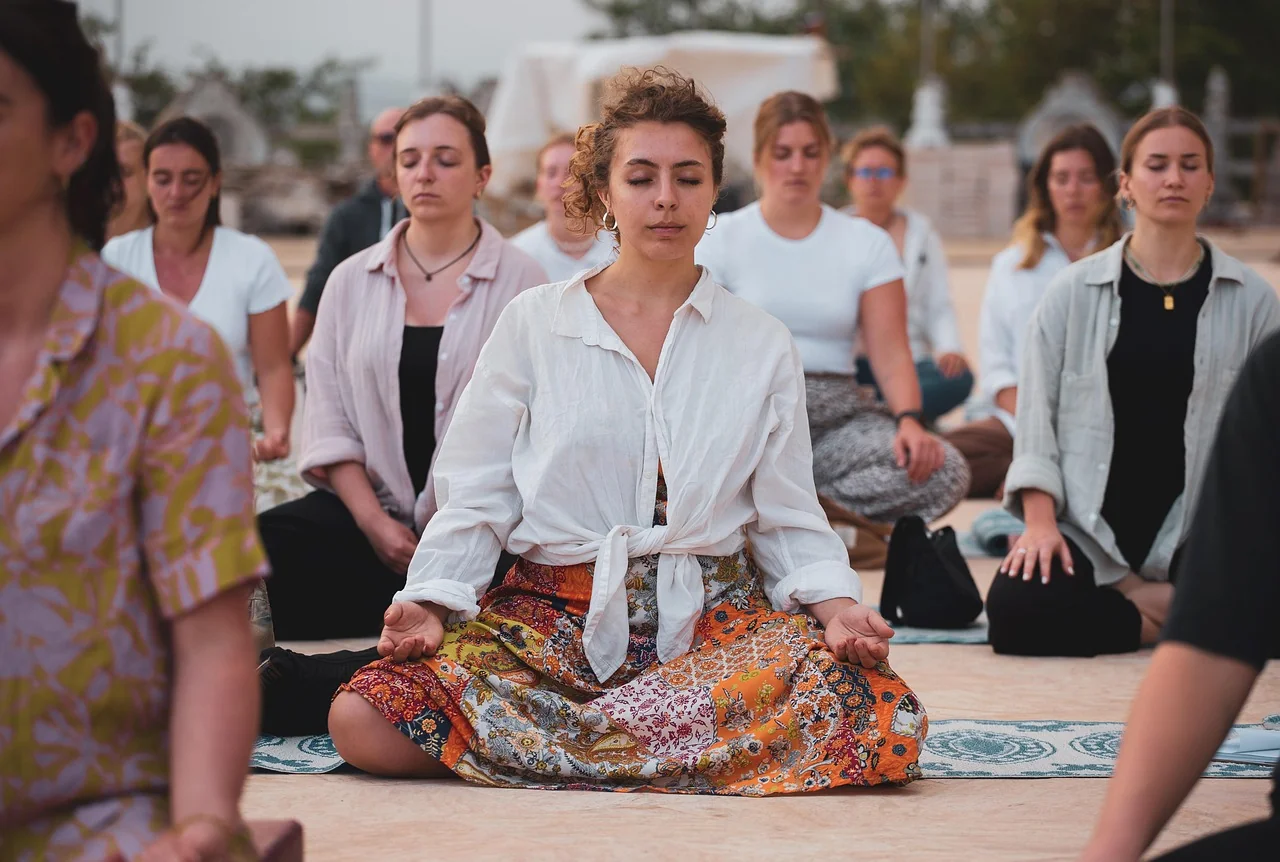Feeling overwhelmed, stressed, or just constantly switched on? You’re not alone. In our non-stop world, finding a moment of peace can feel like a luxury. But what if you could access a powerful tool to quiet the noise, completely free of charge? Welcome to the transformative world of free guided meditation. This practice is your accessible gateway to calm, offering a structured path to stillness with the support of an expert voice leading the way, requiring nothing more than a few minutes of your time and a willingness to try.
This ultimate guide is designed to demystify the process and show you exactly how to build a sustainable meditation habit without spending a dime. We'll explore the profound science-backed benefits for your mind and body, walk you through your very first session with confidence, and curate the best free resources available today. Whether you're a complete beginner or looking to deepen your practice, consider this your roadmap to finding clarity, reducing stress, and reclaiming your inner peace. Let’s begin your journey.
What is Free Guided Meditation and Why It's a Game-Changer
Guided meditation is a practice where you are led through a meditative process by an experienced teacher or narrator. Think of it as having a personal guide for your mind. This guide uses verbal instructions to help you focus your attention, visualize calming scenes, or navigate bodily sensations. They provide a structure that makes it significantly easier to quiet a busy brain, especially when you're just starting out.
The "free" aspect is what makes this practice truly revolutionary. It removes all barriers to entry. There's no financial commitment, no expensive classes, and no pressure. You can access a world of expert teaching from your smartphone, computer, or tablet, anytime and anywhere. This democratizes mental wellness, making tools for resilience and calm available to everyone, regardless of their circumstances.
Many people hesitate to start meditating because they believe it's about "stopping your thoughts" or achieving a state of perfect, empty-minded bliss. This is a common misconception. Guided meditation reframes this goal. It’s not about fighting your thoughts, but about learning to observe them without getting swept away. Your guide gently brings your attention back when it wanders, training your mind in the same way you’d train a muscle at the gym. It’s a practical, accessible, and highly effective form of mental training.
The Tangible Benefits: Why Your Mind and Body Crave Guided Meditation
The positive effects of a consistent guided meditation practice extend far beyond a few minutes of daily calm. Science continues to uncover a host of mental, physical, and emotional benefits that can transform your quality of life.
Mental and Emotional Shifts
The most immediate benefits are often felt in your mind and mood. Regular practice can lead to:
- Reduced Stress and Anxiety: Guided meditation actively dials down your body's stress response. By focusing on the breath and calming instructions, it lowers cortisol levels (the stress hormone) and teaches your nervous system that it's safe to relax. If you're specifically looking for support, explore our guide to the best guided meditation for anxiety.
- Improved Focus and Concentration: Each time you gently guide your attention back to the narrator's voice, you are strengthening your brain's "attention muscle." This enhanced focus carries over into your work, studies, and daily tasks, combating the effects of constant digital distractions.
- Enhanced Emotional Regulation: Meditation creates a small gap between a triggering event and your reaction. This pause allows you to respond to situations with more clarity and less impulsivity, leading to better decision-making and healthier relationships.
- Better Sleep Quality: Many guided meditations are specifically designed for sleep. They help quiet the "monkey mind" that races at night, guiding your body and brain into a state conducive to deep, restorative rest.
Physical Well-being and Body Awareness
Your mind and body are deeply connected, and the calm cultivated in meditation manifests physically.
- Lower Blood Pressure: The relaxation response induced by meditation can help reduce strain on your heart and blood vessels over time.
- Strengthened Immune Function: Studies suggest that regular meditators may produce more antibodies in response to vaccines and show greater resistance to illness.
- Reduced Physical Tension: As you mentally scan your body during a practice, you become aware of areas holding tension—like tight shoulders or a clenched jaw. This awareness is the first step toward consciously releasing that physical stress.
- Pain Management: While not a cure, meditation can change your relationship with chronic pain. By observing discomfort with less judgment and resistance, the perceived intensity of pain can often decrease.
Your First Session: A Step-by-Step Guide to Free Guided Meditation
Starting your first session can feel daunting, but it's much simpler than you think. Follow these steps to create a smooth and positive introduction to your practice.
Step 1: Create Your Environment Find a relatively quiet space where you won't be interrupted for the duration of your session. You don't need a soundproof room; just a corner of your bedroom or living room will do. Sit in a comfortable chair with your back straight but not rigid, or cross-legged on the floor with a cushion for support. The key is to be alert yet comfortable. You can also lie down, but be aware this might lead to falling asleep.
Step 2: Choose Your Meditation For your first time, select a short, beginner-focused session. Look for titles like "5-Minute Meditation for Beginners," "Introduction to Mindfulness," or "Breathing Exercise for Calm." A short commitment feels less intimidating and is easier to fit into your day. A perfect place to start is with a free 5 minute meditation to build the habit without pressure.
Step 3: Set Your Intention and Posture Before you press play, take a moment. Set a simple, kind intention, such as "I'm doing this to be kind to myself" or "I'm open to whatever happens." Gently close your eyes or soften your gaze. Notice the points of contact between your body and the chair or floor. Take one or two deep, conscious breaths to signal to your body that it's time to shift gears.
Step 4: Press Play and Simply Listen Start the audio. Your only job is to listen to the guide's voice and follow their instructions as best you can. They might ask you to focus on your breath, the sounds around you, or sensations in your body.
Step 5: Navigate Wandering Thoughts Your mind will wander. This is not a sign of failure; it is the entire point of the practice. The moment you realize your thoughts have drifted to your to-do list or a conversation from earlier, simply acknowledge it without judgment—"Ah, thinking"—and gently return your focus to the guide's voice. This act of noticing and returning is the core repetition of mental training.
Step 6: Conclude Gently When the session ends, don't jump up immediately. Take a few moments to slowly wiggle your fingers and toes, notice how your body feels, and gradually open your eyes. Carry this sense of mindful awareness with you as you move into your next activity.
Finding Your Perfect Practice: A Curated Guide to Free Meditation Resources
The digital world is rich with high-quality, free guided meditation content. Here’s a breakdown of the best platforms and what they offer.
Meditation Apps with Strong Free Tiers
You don't always need a paid subscription to benefit from top-tier meditation apps.
- Insight Timer: This is arguably the king of free meditation content. It boasts a massive library of over 100,000 free guided meditations from thousands of teachers. You can filter by length, topic (sleep, anxiety, focus), teacher, and even background music. The timer function for unguided meditation is also excellent.
- Smiling Mind: A completely free, non-profit app developed by psychologists and educators. Their programs are scientifically designed and tailored to different age groups and life stages, making it a fantastic choice for the whole family.
- Healthy Minds Program: Another fully free, science-based app built on a framework of well-being from the Center for Healthy Minds at the University of Wisconsin–Madison. It combines meditation with podcast-style lessons on the science of the mind.
- Waking Up (Free for 30 days, then by request): While technically a paid app, creator Sam Harris is committed to making it accessible to anyone who can't afford it. You can simply email their support team to request a free annual subscription, no questions asked.
YouTube Channels
YouTube is a treasure trove of guided meditations, often with calming visuals.
- The Honest Guys: Known for their high-quality productions and soothing voices, they offer a vast range of meditations, from short anxiety relief sessions to epic 45-minute visualizations.
- Great Meditation: Provides well-structured, accessible guided meditations on topics like stress, self-esteem, and healing, often accompanied by beautiful music.
- Meditative Mind: A great resource if you are drawn to sound. They offer meditations set to solfeggio frequencies and calming music, alongside more traditional guided practices.
Podcasts and Websites
For an audio-only experience that doesn't require an app, podcasts are perfect.
- Tara Brach: A renowned psychologist and meditation teacher, Tara Brach’s podcast features weekly talks and guided meditations that blend Western psychology and Eastern spiritual practices with profound wisdom and compassion.
- UCLA Mindful Awareness Research Center: This resource provides a collection of free, downloadable guided meditations in multiple languages, led by the center's director, Diana Winston.
- The Daily Meditation Podcast: Offers daily, short episodes (usually under 10 minutes) on a wide variety of themes, making it easy to build a consistent daily habit.
Overcoming Common Hurdles: Tips for a Consistent Meditation Habit
Building a new habit comes with challenges. Recognizing and preparing for these common hurdles is the key to a lasting practice.
"I don't have enough time." The beauty of meditation is that even a few minutes count. Start with just 3-5 minutes per day. You can always find 5 minutes—perhaps when you first wake up, during a lunch break, or right before bed. Consistency with a short practice is far more powerful than sporadic hour-long sessions.
"I can't stop my thoughts." This is the most universal experience for meditators. Remember, the goal is not to empty your mind, but to change your relationship with your thoughts. Every time you notice your mind has wandered and you gently bring it back, you have just completed a successful "rep" of mental training. The wandering is not the failure; the failure is giving up entirely.
"I get too restless or frustrated." It's normal to feel physically restless or impatient. If this happens, try a walking meditation instead of a seated one. Or, explore different styles of guided meditation—perhaps a body scan or a loving-kindness practice will resonate more with you than a breath-focused one. The guide's voice and style also matter immensely; don't be afraid to "shop around" until you find a teacher you connect with.
"I keep forgetting to do it." Habit stacking is a powerful technique. Link your meditation practice to an existing habit. For example, "After I brush my teeth in the morning, I will sit for 5 minutes." You can also set a phone reminder or leave your meditation cushion in a visible spot as a visual cue.
Deepening Your Journey: Next Steps After Mastering the Basics
Once you've established a consistent routine with short, guided sessions, you may feel ready to explore further. This is a natural progression in your mindfulness journey.
Experiment with Different Styles Guided meditation is a broad category. Delve into specific techniques to see what serves you best.
- Body Scan: A practice of moving your awareness systematically through different parts of the body, excellent for relaxation and releasing physical tension. You can follow a structured guided meditation script for relaxation to guide you through this process.
- Loving-Kindness (Metta): Focuses on cultivating feelings of goodwill and compassion, first for yourself and then radiating out to others. A guided meditation for love is a wonderful way to explore this practice.
- Visualization: Uses detailed mental imagery to evoke feelings of calm, confidence, or healing.
Try Unguided Meditation After relying on a guide, you might feel a pull to sit in silence. Start by using a simple timer. Set it for just 5 minutes and focus on your breath or a mantra. It will feel different, but it’s a powerful way to build self-reliance in your practice.
Explore a Specific Tradition or Teacher You may have found that you're particularly drawn to the teachings of a specific person, like Tara Brach or Sam Harris. Dive deeper into their work by reading their books or listening to their longer talks.
Connect with a Community While meditation is an internal practice, it can be enriched by community. Look for local meditation groups (often called "sanghas") or online communities where you can share experiences and ask questions. Insight Timer, for example, has a strong social community feature within the app.
Frequently Asked Questions About Free Guided Meditation
Is free guided meditation as effective as paid apps? Absolutely. The core mechanism—a guiding voice leading you through a mindful process—is identical. Paid apps often offer more structured "courses," but the foundational practice of a single guided session is just as powerful, whether it's free or paid.
How long does it take to see results? Some benefits, like a sense of immediate calm after a session, can be felt right away. More lasting changes in your baseline stress levels, focus, and emotional reactivity typically become noticeable after a few weeks of consistent, daily practice.
What is the best time of day to meditate? The best time is the time you can consistently do it. Many people prefer the morning to set a calm tone for the day. Others find a midday session helps combat afternoon slumps, while an evening practice can aid in letting go of the day's stress for better sleep. Experiment to find what fits your rhythm. A guided meditation morning routine can be a powerful way to start your day with intention.
I fell out of my habit. How do I start again? This happens to everyone. The key is to approach it with self-compassion, not self-criticism. Don't try to jump back in where you left off. Just as you did at the very beginning, commit to just one, short 3-5 minute session. Re-establish the habit gently, without judgment for the time you missed.
In summary, guided meditation is a profoundly accessible and effective tool for cultivating mental and physical well-being. This practice requires no prior experience or special equipment, making it an ideal starting point for anyone seeking to reduce stress, enhance focus, or simply find a moment of daily calm. The key to success lies in consistency; even a few minutes each day can yield significant benefits, from improved emotional regulation to better sleep. Remember that exploring different styles and instructors is part of the journey to discovering what truly resonates with you. Let this exploration be an act of self-care, not another item on a checklist. The path to a more centered and peaceful life is readily available. Your next guided session is waiting, offering a quiet sanctuary and a powerful step toward lasting inner balance. Begin today, and discover the transformative power of your own mindful presence.


